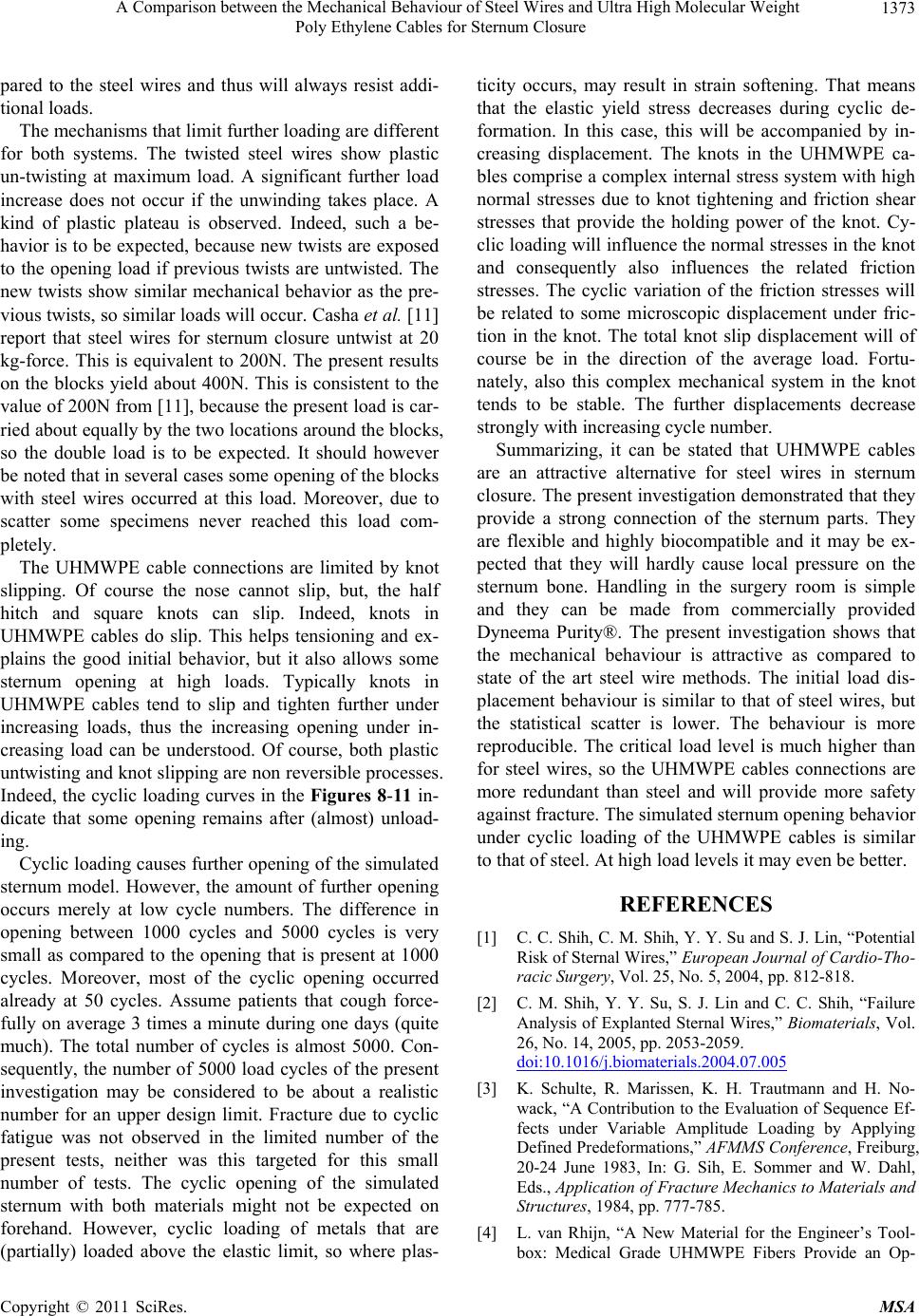
A Comparison between the Mechanical Behaviour of Steel Wires and Ultra High Molecular Weight 1373
Poly Ethylene Cables for Sternum Closure
pared to the steel wires and thus will always resist addi-
tional load s.
The mechanisms that limit further loading are different
for both systems. The twisted steel wires show plastic
un-twisting at maximum load. A significant further load
increase does not occur if the unwinding takes place. A
kind of plastic plateau is observed. Indeed, such a be-
havior is to be expected, because new twists are exposed
to the opening load if previous twists are untwisted. The
new twists show similar mechanical behavior as the pre-
vious twists, so similar loads will occur. Cash a et al. [11]
report that steel wires for sternum closure untwist at 20
kg-force. This is equivalent to 200N. The present results
on the blocks yield about 400N. This is consistent to the
value of 200N from [11], because the present load is car-
ried about equally by the two locations around the blocks,
so the double load is to be expected. It should however
be noted that in several cases some opening of the blocks
with steel wires occurred at this load. Moreover, due to
scatter some specimens never reached this load com-
pletely.
The UHMWPE cable connections are limited by knot
slipping. Of course the nose cannot slip, but, the half
hitch and square knots can slip. Indeed, knots in
UHMWPE cables do slip. This helps tensioning and ex-
plains the good initial behavior, but it also allows some
sternum opening at high loads. Typically knots in
UHMWPE cables tend to slip and tighten further under
increasing loads, thus the increasing opening under in-
creasing load can be understood. Of course, both plastic
untwisting and knot slipping are non reversible processes.
Indeed, the cyclic loading curves in the Figures 8-11 in-
dicate that some opening remains after (almost) unload-
ing.
Cyclic loading causes further opening of the simulated
sternum model. However, the amount of further opening
occurs merely at low cycle numbers. The difference in
opening between 1000 cycles and 5000 cycles is very
small as compared to the opening that is present at 1000
cycles. Moreover, most of the cyclic opening occurred
already at 50 cycles. Assume patients that cough force-
fully on average 3 times a minute during one days (quite
much). The total number of cycles is almost 5000. Con-
sequently, the number of 5000 load cycles of the present
investigation may be considered to be about a realistic
number for an upper design limit. Fracture due to cyclic
fatigue was not observed in the limited number of the
present tests, neither was this targeted for this small
number of tests. The cyclic opening of the simulated
sternum with both materials might not be expected on
forehand. However, cyclic loading of metals that are
(partially) loaded above the elastic limit, so where plas-
ticity occurs, may result in strain softening. That means
that the elastic yield stress decreases during cyclic de-
formation. In this case, this will be accompanied by in-
creasing displacement. The knots in the UHMWPE ca-
bles comprise a complex internal stress system with high
normal stresses due to knot tightening and friction shear
stresses that provide the holding power of the knot. Cy-
clic loading will influence the normal stresses in the knot
and consequently also influences the related friction
stresses. The cyclic variation of the friction stresses will
be related to some microscopic displacement under fric-
tion in the knot. The total knot slip displacement will of
course be in the direction of the average load. Fortu-
nately, also this complex mechanical system in the knot
tends to be stable. The further displacements decrease
strongly with increasing cycle number.
Summarizing, it can be stated that UHMWPE cables
are an attractive alternative for steel wires in sternum
closure. The present investigation demonstrated that they
provide a strong connection of the sternum parts. They
are flexible and highly biocompatible and it may be ex-
pected that they will hardly cause local pressure on the
sternum bone. Handling in the surgery room is simple
and they can be made from commercially provided
Dyneema Purity®. The present investigation shows that
the mechanical behaviour is attractive as compared to
state of the art steel wire methods. The initial load dis-
placement behaviour is similar to that of steel wires, but
the statistical scatter is lower. The behaviour is more
reproducible. The critical load level is much higher than
for steel wires, so the UHMWPE cables connections are
more redundant than steel and will provide more safety
against fracture. The simulated sternum opening behavior
under cyclic loading of the UHMWPE cables is similar
to that of steel. At high load levels it may even be better.
REFERENCES
[1] C. C. Shih, C. M. Shih, Y. Y. Su and S. J. Lin, “Potential
Risk of Sternal Wires,” European Journal of Cardio-Tho-
racic Surgery, Vol. 25, No. 5, 2004, pp. 812-818.
[2] C. M. Shih, Y. Y. Su, S. J. Lin and C. C. Shih, “Failure
Analysis of Explanted Sternal Wires,” Biomaterials, Vol.
26, No. 14, 2005, pp. 2053-2059.
doi:10.1016/j.biomaterials.2004.07.005
[3] K. Schulte, R. Marissen, K. H. Trautmann and H. No-
wack, “A Contribution to the Evaluation of Sequence Ef-
fects under Variable Amplitude Loading by Applying
Defined Predeformations,” AFMMS Conference, Freiburg,
20-24 June 1983, In: G. Sih, E. Sommer and W. Dahl,
Eds., Application of Fracture Mechanics to Materials and
Structures, 1984, pp. 777-785.
[4] L. van Rhijn, “A New Material for the Engineer’s Tool-
box: Medical Grade UHMWPE Fibers Provide an Op-
Copyright © 2011 SciRes. MSA